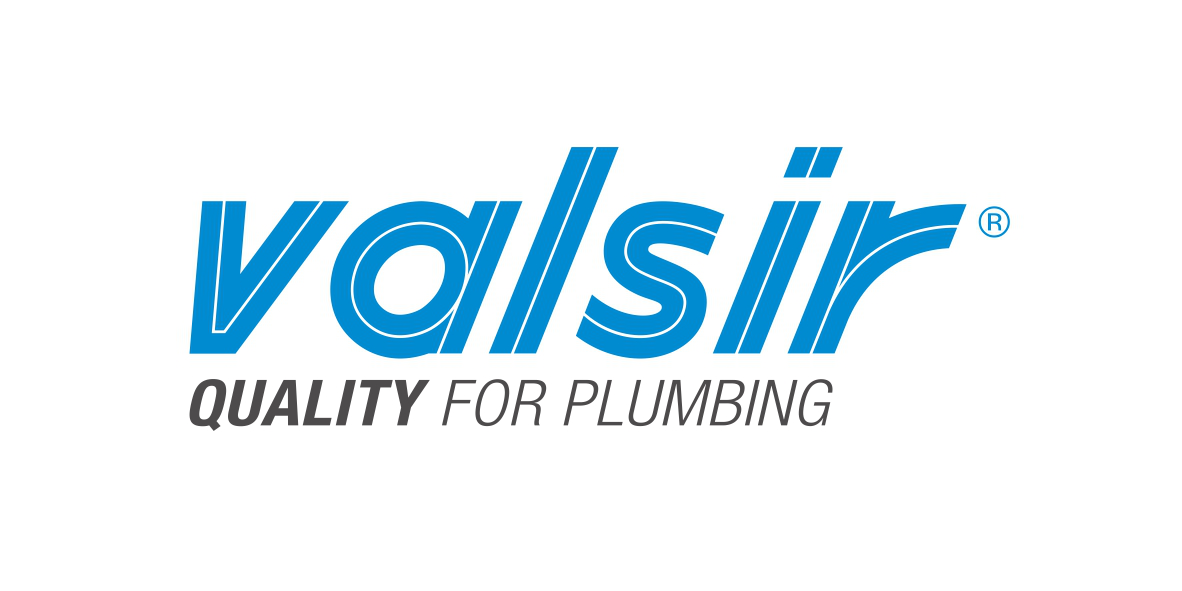
ACOUSTIC
TRIPLUS
THE EVOLUTION OF SOUNDPROOF WASTE SYSTEMS
Triplus pipes are made up of three layers of material, which, when joined, result in a system with extremely good mechanical characteristics, even at low temperatures, and an excellent soundproofing performance.
Triplus is a push-fit system that guarantees the levels of low noise emissions of waste systems required by the regulations, laws and standards in force.
The outer layers of Triplus are made of polypropylene (PP) to make the pipe resistant to mechanical stress and impact as well as chemical agents.
The intermediate layer of the pipe is made from a patented mix of polypropylene (PP) and mineral fillers (MF) that gives the Triplus system excellent mechanical qualities at both low (impact resistance down to -25°C) and high temperatures (up to 95°C).
The system can transport waste water with a pH value between 2 and 12 and is characterised by an extremely smooth inner surface, which prevents the build-up of internal deposits inside the waste network

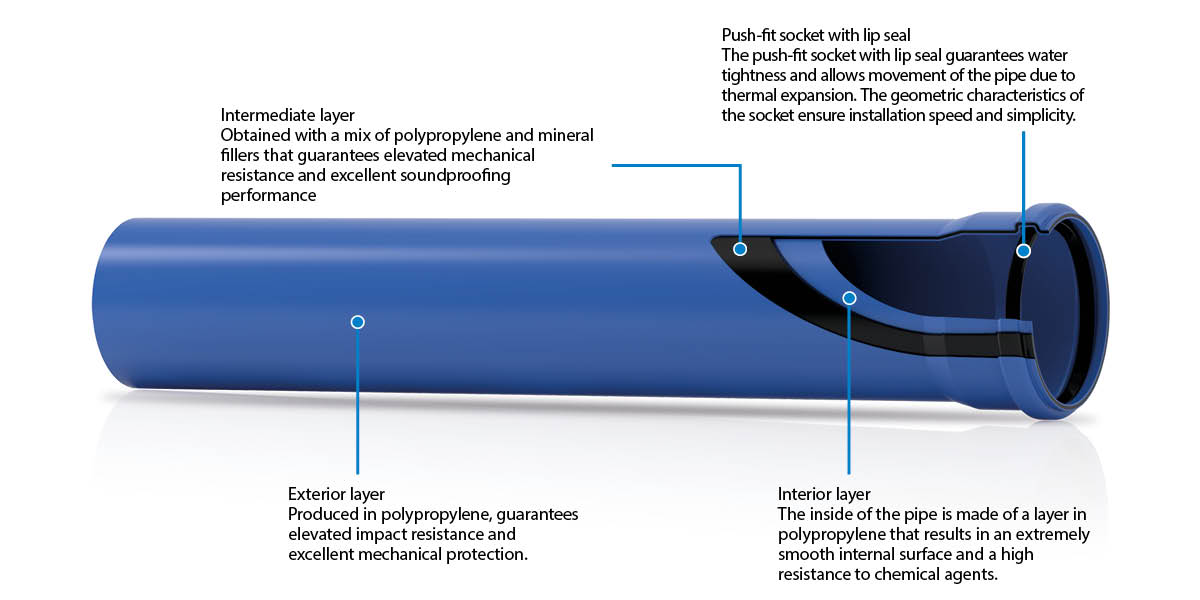
The advantages of using the Triplus waste system
- Speed and extreme ease of installation on site without the use of special tools, thanks to the push-fit The socket connection, moreover, does not require the use of glues or harmful solvents.
- Excellent soundproofing performance: measured in the Fraunhofer laboratories in Stuttgart, in compliance with European Standard EN 14366, less than 10 dB(A) at a flow rate of 2 l/s and 12 dB(A) at a flow rate of 4 l/s (certified P-BA 105/2024).
- High impact resistance at extremely harsh temperatures down to -25°C.
- Resistance to intermittent discharges at temperatures as high as 95°C.
- The pipes are made up of three layers of material joined together to guarantee elevated mechanical
- High chemical resistance to substances dissolved in civil and industrial waste
- Wide range of transition fittings for connection to other waste systems in cast iron, PE, PP,
- Wide range of diameters from DN 32 mm to DN 250 mm.
- The product, its recyclability and the production processes are based on Green Building principles which promote respect for the environment and the conservation of natural resources.
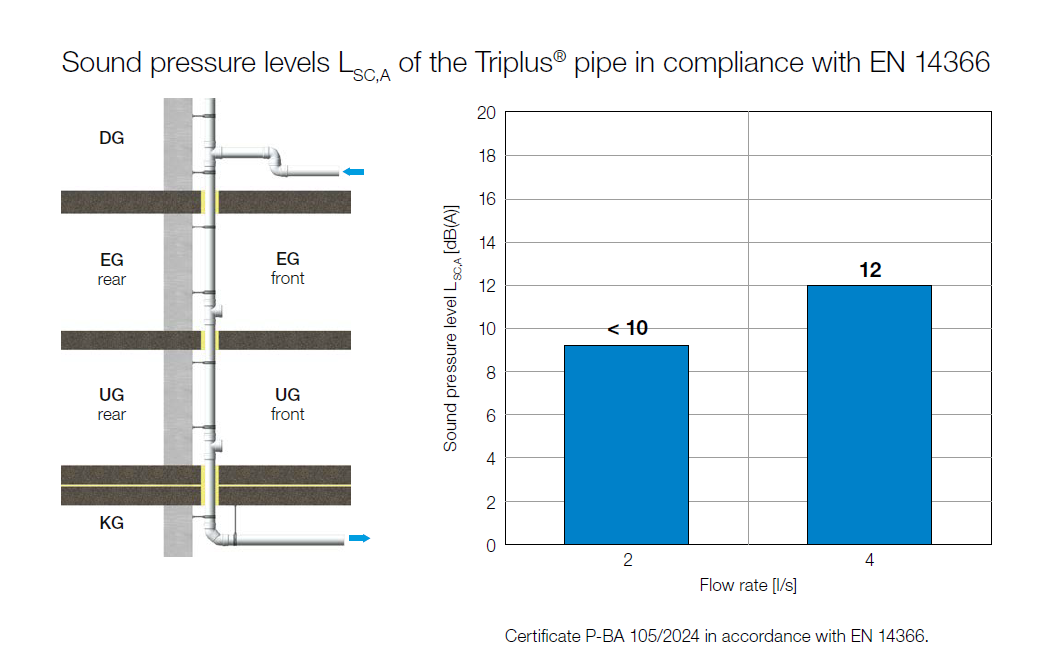
When a waste system is in use, noises are generated inside the pipelines causing it to vibrate from the fall of the liquid being discharged.
Most of the noise generated spreads inside the pipe but the vibrations that are generated are transmitted from the walls of the pipe to the surrounding area and to the bracketing systems and consequently to the building structure.
To minimize noise levels in waste and drainage systems, not only should the system be properly designed and the waste circuit be mounted correctly, but it is also important to choose a system with an elevated soundproofing performance.
Triplus allows waste systems to be installed that guarantee excellent soundproofing performance, with 2 l/s (typical waste from a toilet), noise levels of less than 10 dB(A) are measured.
The extraordinary soundproofing performance of Triplus® have also been demonstrated by laboratory tests conducted at the CSIRO Australian complying with the requirements of the Building Code of Australia.
VBF (VENTILATION BRANCH FITTING)
The Ventilation Branch Fitting is a complex geometric fitting that allows the connection of multiple horizontal branches to the main vertical column, managing waste and ventilation in an integrated manner. The operating principle is based on the physical and dynamic separation of the flows coming from different branches, ensuring controlled mixing and avoiding turbulence and pressure variations that could compromise the functionality of the siphons.
The VBF has six inlets: three upper ones for large waste flows (e.g. toilets) and three lower ones for smaller waste flows (e.g. washbasins, bidets). The internal structure comprises three functional areas: a diversion chamber, a mixing chamber and a deflector, each with the specific task of reducing the flow velocity, stabilising the pressure and ensuring optimal ventilation of the network.
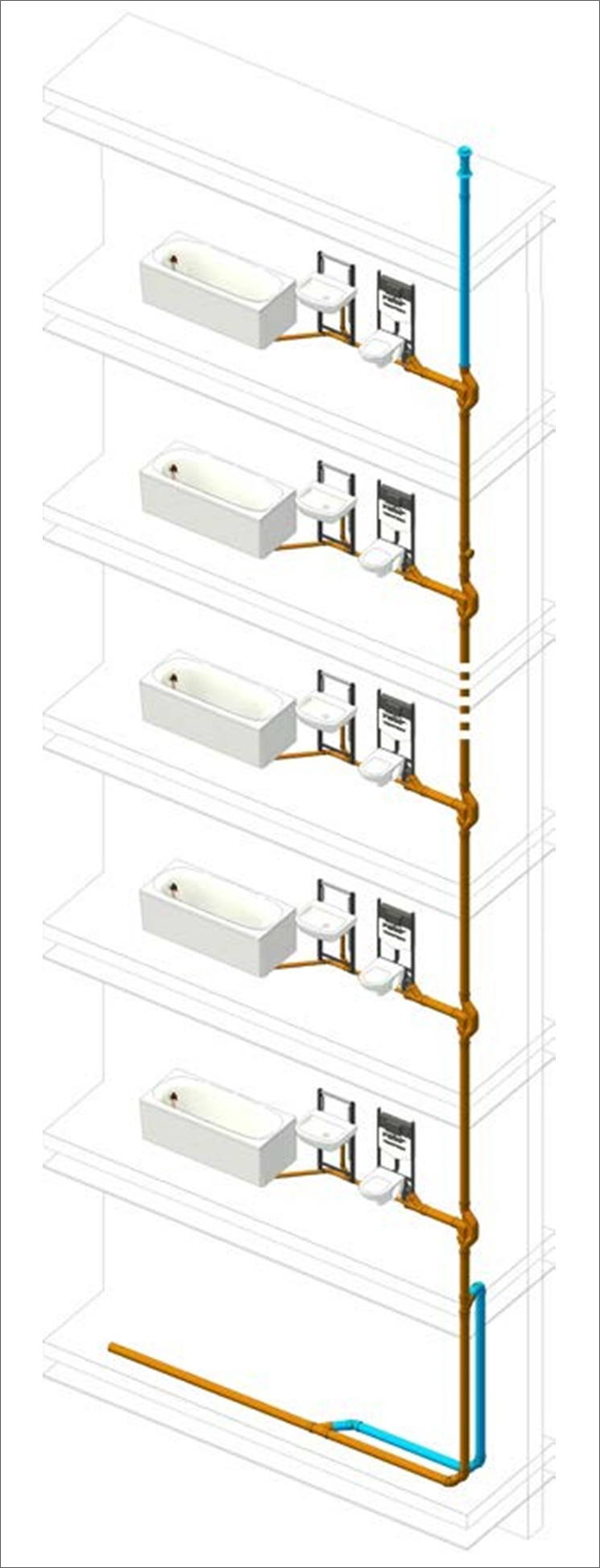
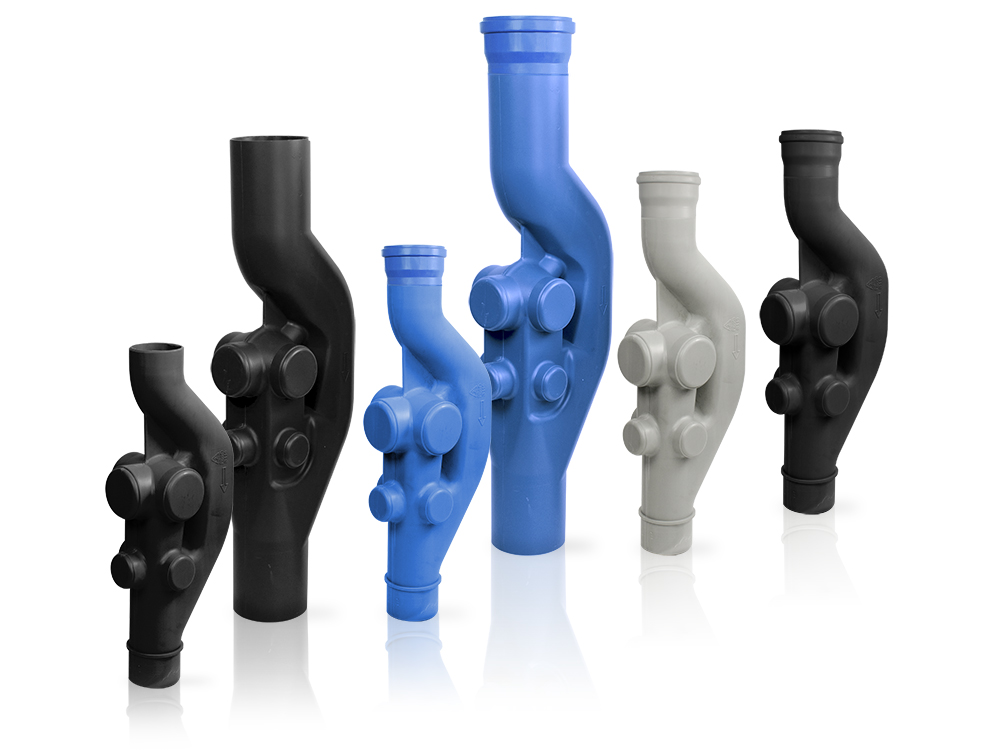
This innovative waste system guarantees excellent ventilation of the stack and branch connections on each floor thus limiting pressure fluctuations within the system.
This system also allows significant advantages in terms of cost savings thanks to the possibility of creating one soil stack (therefore no separate ventilation pipes are required) with one 110 mm diameter with over double the discharge capacities of primary ventilation systems.
The ideal solution for high rise buildings
- One soil stack, no separate ventilation pipes required.
- Increase in stack load in comparison with conventional systems.
- Reduction in speed of waste
- Excellent ventilation of the stack and branches of each floor.
- Up to 6* connections on one branch fitting.
- Up to 45** bathrooms connected to the same soil stack.
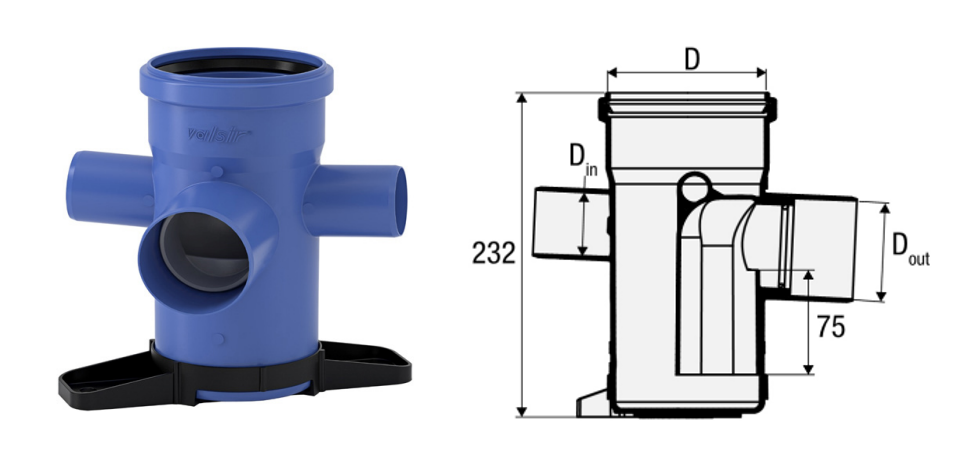
T-TRAP (TRIPLUS GULLY)
Trapped gully made of Triplus composed of a 110 mm diameter top inlet with seal, three 50 mm diameter side inlets, one 75 mm diameter side outlet.
The side inlets are blank and can be drilled out. The gully has a 75 mm water seal, inlet connections with socket and seals and is completely accessible; it is supplied with an adjustable lower support for ceiling installations
RAINPLUS
RAINPLUS REPRESENT STATE-OF-THE-ART TECHNOLOGY FOR THE DRAINAGE AND COLLECTION OF RAINWATER FROM THE ROOFS OF MEDIUM AND LARGE BUILDING
The system makes use of the height of the building as a driving force, which, combined with a vacuum effect, allows high drainage speeds to be achieved, thereby maximising drainage efficiency. This is how Rainplus is able to handle even extreme and sudden rainfall, preventing damage or flooding of the underlying structures.
Rainplus allows the entire drainage flow rate to be channelled to any area of the building, to facilitate the recovery and reuse of rainwater. This action is not only required by the Green Building Council’s directives, but made more and more topical by the issue of climate emergency.
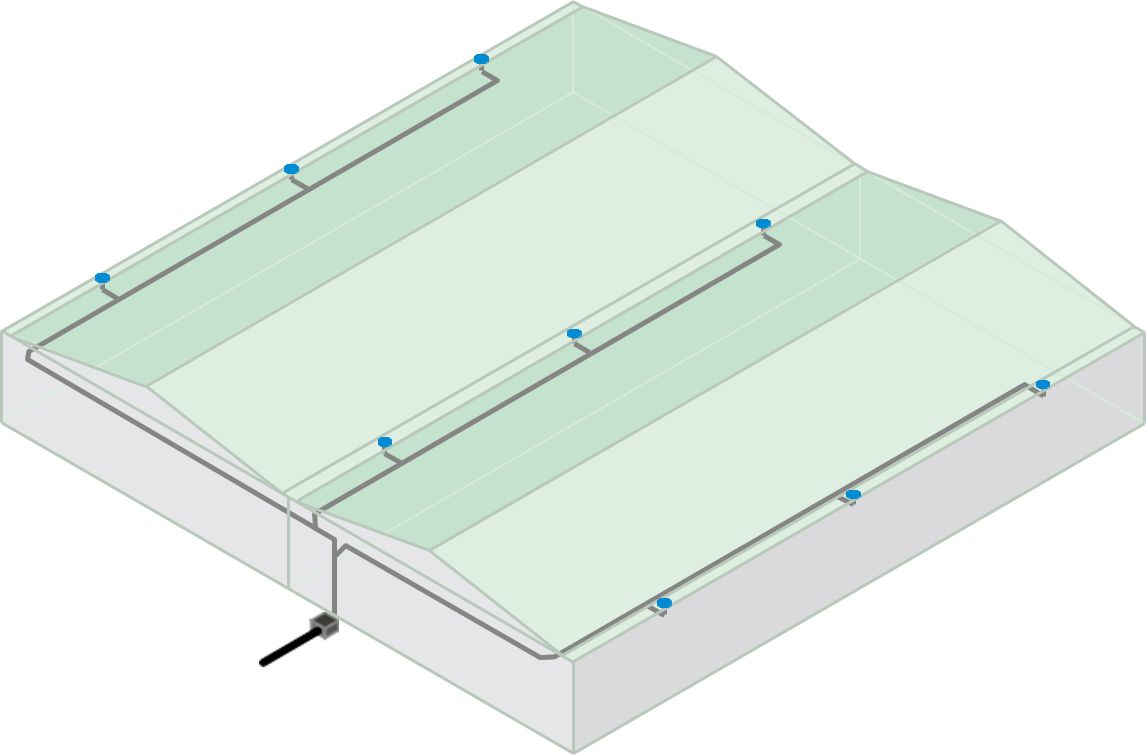
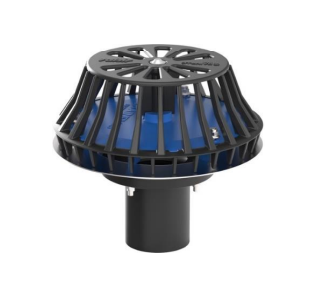
Rainplus is defined as a siphonic rainwater drainage system because it is based on the same principleas a siphon. The siphon is in general a reversed U shaped pipe used to pour a fluid from one container to another located in a lower position.
When the pipe is full, the fluid contained in the longer stretch of pipe tends to fall due to its weight causing the suction of the liquid in the shorter section, which is lighter in weight.
This process only starts when the pipe is completely full and continues until a balance between the two containers is reached: either when the two containers reach the same level or when the fluid level in the higher container goes below the pipe inlet section.
The driving force that causes this effect is a result of the difference in height of the two containers: the bigger the difference, the stronger the driving force and, as a consequence, the greater the flow speed in the pipe.
The performances of the Rainplus siphonic drainage system are therefore decidedly better than those of a conventional system where the driving force is generated exclusively by the amount of water that accumulates on the roof. When the siphonic drainage system works at full capacity, the “siphon effect” is triggered resulting in a driving force that is proportionate to the height of the roof and the end of the circuit, which is typically located at ground level.
Such power generates levels of positive and negative pressures in specific points of the circuit in this way the speed and, as a consequence, the flow rates of the system (Bernoulli’s principle) are rapidly increased.
